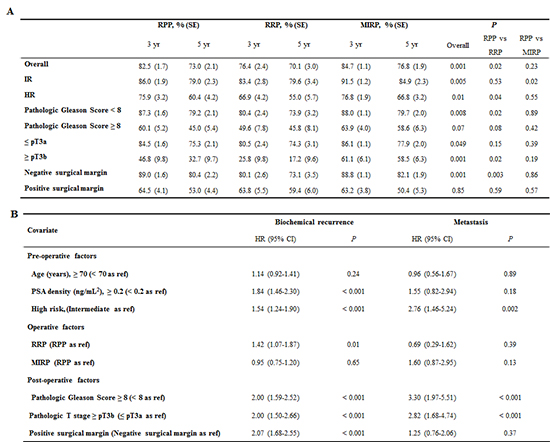1. Rodrigues G, Warde P, Pickles T, Crook J, Brundage M, Souhami L, Lukka H. Genitourinary Radiation Oncologists of Canada. Pre-treatment risk stratification of prostate cancer patients: a critical review. Can Urol Assoc J. 2012; 6:121–127.
2. Cooperberg MR, Lubeck DP, Mehta SS, Carroll PR. CaPSURE. Time trends in clinical risk stratification for prostate cancer: implications for outcomes (data from CaPSURE). J Urol. 2003; 170:S21–S25.
3. Ischia J, Gleave M. Radical prostatectomy in high-risk prostate cancer. Int J Urol. 2013; 20:290–300.
4. Eggener SE, Scardino PT, Walsh PC, Han M, Partin AW, Trock BJ, Feng Z, Wood DP, Eastham JA, Yossepowitch O, et al. Predicting 15-year prostate cancer specific mortality after radical prostatectomy. J Urol. 2011; 185:869–875.
5. Young HH. The early diagnosis and radical cure of carcinoma of the prostate: being a study of 40 cases and presentation of a radical operation which was carried out in 4 cases. Bull Johns Hopkins Hosp. 1905; 16:315–321.
6. Nargund VH, Zaman F. Radical prostatectomy: too soon to abandon the perineal approach? Nat Rev Urol. 2011; 8:179–180.
7. Comploj E, Palermo S, Trenti E, Martini T, Lodde M, Mian C, Mazzoleni G, Pycha A. Radical perineal prostatectomy: an outdated procedure? Int J Surg. 2011; 9:400–403.
8. Gianino MM, Galzerano M, Martin B, Chiadò Piat S, Gontero P. Costs in surgical techniques for radical prostatectomy: a review of the current state. Urol Int. 2012; 88:1–5.
9. Mirza M, Art K, Wineland L, Tawfik O, Thrasher JB. A comparison of radical perineal, radical retropubic, and robot-assisted laparoscopic prostatectomies in a single surgeon series. Prostate Cancer. 2011; 2011:878323.
10. Eliya F, Kernen K, Gonzalez J, Peters K, Ibrahim I, Petzel K. Radical perineal prostatectomy: a learning curve? Int Urol Nephrol. 2011; 43:139–142.
11. Briganti A, Larcher A, Abdollah F, Capitanio U, Gallina A, Suardi N, Bianchi M, Sun M, Freschi M, Salonia A, et al. Updated nomogram predicting lymph node invasion in patients with prostate cancer undergoing extended pelvic lymph node dissection: the essential importance of percentage of positive cores. Eur Urol. 2012; 61:480–487.
12. Kawakami J, Meng MV, Sadetsky N, Latini DM, Duchane J, Carroll PR. CaPSURE Investigators. Changing patterns of pelvic lymphadenectomy for prostate cancer: results from CaPSURE. J Urol. 2006; 176:1382–1386.
13. Feifer AH, Elkin EB, Lowrance WT, Denton B, Jacks L, Yee DS, Coleman JA, Laudone VP, Scardino PT, Eastham JA. Temporal trends and predictors of pelvic lymph node dissection in open or minimally invasive radical prostatectomy. Cancer. 2011; 117:3933–3942.
14. Catalona WJ, Smith DS. Cancer recurrence and survival rates after anatomic radical retropubic prostatectomy for prostate cancer: intermediate-term results. J Urol. 1998; 160:2428–2434.
15. Abdollah F, Schmitges J, Sun M, Tian Z, Briganti A, Shariat SF, Perrotte P, Montorsi F, Karakiewicz PI. A critical assessment of the value of lymph node dissection at radical prostatectomy: A population-based study. Prostate. 2011; 71:1587–1594.
16. Mohler J, Bahnson RR, Boston B, Busby JE, D'Amico A, Eastham JA, Enke CA, George D, Horwitz EM, Huben RP, et al. NCCN clinical practice guidelines in oncology: prostate cancer. J Natl Compr Canc Netw. 2010; 8:162–200.
17. Lezin MS, Cherrie R, Cattolica EV. Comparison of laparoscopic and minilaparotomy pelvic lymphadenectomy for prostate cancer staging in a community practice. Urology. 1997; 49:60–63.
18. Parra RO, Boullier JA, Rauscher JA, Cummings JM. The value of laparoscopic lymphadenectomy in conjunction with radical perineal or retropubic prostatectomy. J Urol. 1994; 151:1599–1602.
19. Pierorazio PM, Guzzo TJ, Han M, Bivalacqua TJ, Epstein JI, Schaeffer EM, Schoenberg M, Walsh PC, Partin AW. Long-term survival after radical prostatectomy for men with high Gleason sum in pathologic specimen. Urology. 2010; 76:715–721.
20. Herrmann TR, Rabenalt R, Stolzenburg JU, Liatsikos EN, Imkamp F, Tezval H, Gross AJ, Jonas U, Burchardt M. Oncological and functional results of open, robot-assisted and laparoscopic radical prostatectomy: does surgical approach and surgical experience matter? World J Urol. 2007; 25:149–160.
21. Boccon-Gibod L. Radical prostatectomy: open? Laparoscopic? Robotic? Eur Urol. 2006; 49:598–599.
22. Salomon L, Levrel O, de la Taille A, Anastasiadis AG, Saint F, Zaki S, Vordos D, Cicco A, Olsson LE, Hoznek A, et al. Radical prostatectomy by the retropubic, perineal and laparoscopic approach: 12 years of experience in one center. Eur Urol. 2002; 42:104–110.
23. Ahlering TE, Woo D, Eichel L, Lee DI, Edwards R, Skarecky DW. Robot-assisted versus open radical prostatectomy: a comparison of one surgeon's outcomes. Urology. 2004; 63:819–822.
24. Busch J, Magheli A, Leva N, Hinz S, Ferrari M, Friedersdorff F, Fuller TF, Miller K, Gonzalgo ML. Matched comparison of outcomes following open and minimally invasive radical prostatectomy for high-risk patients. World J Urol. 2014; 32:1411–1416.
25. Furubayashi N, Nakamura M, Hishikawa K, Fukuda A, Matsumoto T, Nishiyama K, Yamanaka T, Hasegawa Y. Radical prostatectomy as radical cure of prostate cancer in a high-risk group: A single-institution experience. Mol Clin Oncol. 2013; 1:337–342.
26. Smith JA Jr, Chan RC, Chang SS, Herrell SD, Clark PE, Baumgartner R, Cookson MS. A comparison of the incidence and location of positive surgical margins in robotic assisted laparoscopic radical prostatectomy and open retropubic radical prostatectomy. J Urol. 2007; 178:2385–2389.
27. Rozet F, Jaffe J, Braud G, Harmon J, Cathelineau X, Barret E, Vallancien G. A direct comparison of robotic assisted versus pure laparoscopic radical prostatectomy: a single institution experience. J Urol. 2007; 178:478–482.
28. Joniau S, Tosco L, Briganti A, Vanden Broeck T, Gontero P, Karnes RJ, Spahn M, Van Poppel H. European Multicenter Prostate Cancer Clinical and Translational research group. Results of surgery for high-risk prostate cancer. Curr Opin Urol. 2013; 23:342–348.
29. Tewari AK, Patel ND, Leung RA, Yadav R, Vaughan ED, El-Douaihy Y, Tu JJ, Amin MB, Akhtar M, Burns M, et al. Visual cues as a surrogate for tactile feedback during robotic-assisted laparoscopic prostatectomy: posterolateral margin rates in 1340 consecutive patients. BJU Int. 2010; 106:528–536.











 PDF
PDF ePub
ePub Citation
Citation Print
Print



 XML Download
XML Download